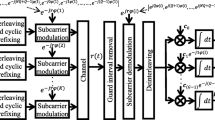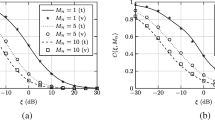Abstract
Radiocommunications in the mmWave band present strong free-space attenuation, which requires power maximization at the receiver. A code division multiple access (CDMA) modulation system increases the receiver’s ability to detect the transmitted signal by means of spectrum spreading. The main benefit of direct sequence spread spectrum for mmWaves is the increase in coverage due to the process gain. The main drawback of its use in high-speed communications is bandwidth reduction. Fortunately, this can be compensated for by the huge bandwidth available at mmWave frequencies. However, most of the codes available for CDMA have mutual interference. The zero correlation zone (ZCZ) codes are orthogonal to each other, but only under the condition that no multipath far echoes are received. This condition is fulfilled in mmWave radio communications, owing to strong propagation attenuation and also because of the beamforming that radio links usually do at this frequency. In this study, a field experiment is carried out consisting of data reception at 28 GHz from many different users who are simultaneously transmitting using CDMA on BPSK modulation and then comparing the performance of conventional maximal pseudorandom (PR) codes versus ZCZ codes. It is verified that the latter are received with the same process gain but no mutual interference, approximately resulting in a 12 dB improvement on the modulation error ratio (MER).





Similar content being viewed by others
Data Availability
The author confirms that all data generated or analyzed during this study are included in this published article.
References
Zhang, G., et al. (2018). Experimental characterization of Millimeter-Wave indoor propagation channels at 28 GHz. Ieee Access : Practical Innovations, Open Solutions, 6, 76516–76526. https://doi.org/10.1109/ACCESS.2018.2882644.
Yin, X., Ling, C., & Kim, M. D. (2015). Experimental multipath-cluster characteristics of 28-GHz Propagation Channel. Ieee Access : Practical Innovations, Open Solutions, 3, 3138–3150. https://doi.org/10.1109/ACCESS.2016.2517400.
Maccartney, G. R., Rappaport, T. S., Sun, S., & Deng, S. (2015). Indoor Office Wideband Millimeter-Wave Propagation Measurements and Channel Models at 28 and 73 GHz for ultra-dense 5G Wireless Networks. Ieee Access : Practical Innovations, Open Solutions, 3, 2388–2424. https://doi.org/10.1109/ACCESS.2015.2486778.
Bas, C. U. (Sept. 2019). “Real-Time Millimeter-Wave MIMO Channel Sounder for Dynamic Directional Measurements,“ IEEE Transactions on Vehicular Technology, 68(9), 8775–8789, https://doi.org/10.1109/TVT.2019.2928341.
Dixon, R. C. (1994). Spread Spectrum systems with Commercial Applications (3rd edition.). John Willey & Sons.
Golay, M., “Complementary series,“ IRE Transactions on Information Theory, 7(2), 82–87, 10.1109/TIT.1961.1057620.7. Grabowski, J., & Hogrefe, D. (April 1961). (2002). SDL and MSC-Based Specification and Automated Test Case Generation for INAP. Telecommunication Systems Journal, 20(3–4), 265–290.
Alejos, A. V., Sanchez, M. G., & Cuiñas, I. (January 2007). Improvement of Wideband Radio Channel Swept Time-Delay Cross-correlation Sounders by using Golay Sequences. IEEE Transactions on Vehicular Technology, 56(1), 362–368. https://doi.org/10.1109/TVT.2006.889581.
Choi, J. H., Chung, H. K., Lee, H., Cha, J., & Lee, H. (2006). Code-Division Multiplexing based MIMO Channel Sounder with loosely synchronous codes and Kasami codes. IEEE Vehicular Technology Conference, 1–5. https://doi.org/10.1109/VTCF.2006.33.
Kim, M., Kim, S., & Lee, H. (2008). A study on a Novel Transmit Scheme for MIMO Channel Sounding Architecture. 2008 IEEE 68th Vehicular Technology Conference, 1–4. https://doi.org/10.1109/VETECF.2008.37.
Fan, P. Z., Suehiro, N., Kuroyanagi, N., & Deng, X. M. (May 1999). Class of binary sequences with zero correlation zone. Electronics Letters, 35(10), 777–779. https://doi.org/10.1049/EL:19990567.
Torii, H., Satoh, M., Matsumoto, T., & Nakamura, M. (2013). “Generalized mutually orthogonal ZCZ sequence sets based on perfect sequences and orthogonal codes,“ 15th International Conference on Advanced Communications Technology (ICACT), 2013, pp. 894–899.
Hunukumbure, M., Allen, B., & Beach, M. A. (2007). “Code Orthogonality for Wideband CDMA Systems With Multiple Transmit Antennas,“ in IEEE Transactions on Vehicular Technology, 56(6), 3749–3756, https://doi.org/10.1109/TVT.2007.904525.
Chang, T., et al. (2022). Efficient fractional sampling clock offset compensation method for Q-band mmWave communication in fiber-to-the-room scenario. 2022 IEEE MTT-S International Wireless Symposium (IWS), Harbin, China, 1–3. https://doi.org/10.1109/IWS55252.2022.9978057.
Haderer, H., Feger, R., Pfeffer, C., & Stelzer, A. (2016). “Millimeter-Wave Phase-Coded CW MIMO Radar Using Zero- and Low-Correlation-Zone Sequence Sets,“ in IEEE Transactions on Microwave Theory and Techniques, 64(12), 4312–4323, https://doi.org/10.1109/TMTT.2016.2613530.
Aliqab, K., Sohaib, M. A., Ali, F., Armghan, A., & Alsharari, M. (Mar. 2023). Employment of self-adaptive bayesian neural network for systematic Antenna design: Improving Wireless Networks functionalities. Micromachines, 14(3), 594. https://doi.org/10.3390/mi14030594.
Shi, Y., Armghan, A., Ali, F., Aliqab, K., & Alsharari, M. (Jan. 2023). Enriching capacity and transmission of hybrid WDM-FSO link for 5G mobility. Photonics, 10(2), 121. https://doi.org/10.3390/photonics10020121.
Alsharari, M., Aliqab, K., Ali, F., & Armghan, A. (2023). Integrated Free-Space Optics and Fiber Optic Network Performance Enhancement for Sustaining 5G High Capacity Communications. International Journal of Optics. 2023. 1–9, https://doi.org/10.1155/2023/8685686.
Funding
This research was funded by the Spanish Government, Ministry of Science and Innovation, under grant number PID2020-112545RB-C52, Xunta de Galicia, grants ED431C 2019/26 and ED481A-2020/049 and the European Regional Development Fund (ERDF).
Author information
Authors and Affiliations
Contributions
All of the authors contributed to the study’s conception and design. The manuscript was mainly written by Pablo Torío who also came to the fundamental conclusions. Analysis of the state of the art, analysis of the results, and partial redaction of the manuscript were carried out by Manuel G. Sánchez. Experiment set-up and measurements were made by Luis A. López-Valcárcel. All of the authors read and approved the final manuscript.
Corresponding author
Ethics declarations
Ethics approval and consent to participate
Not applicable.
Competing interests
On behalf of all authors, the corresponding author states that there is no conflict of interest.
Additional information
Publisher’s Note
Springer Nature remains neutral with regard to jurisdictional claims in published maps and institutional affiliations.
Electronic supplementary material
Below is the link to the electronic supplementary material.
Appendix: experiment details
Appendix: experiment details
Basically, the experiment consists of the following stages:
-
1.
Synthesis of the transmitted signal with Matlab.
-
2.
Translation of the Matlab into a format that is readable by the vector signal generator. This is made by the proprietary Rhode ARB Toolbox application.
-
3.
Cyclic transmission of the synthesized signal from the vector signal generator.
-
4.
Reception of a snapshot, containing many signal cycles, at the IQ analyzer.
-
5.
Import of the snapshot to Matlab for offline processing. Including synchronization, normalization, and error assessment.
-
The data.
The data sent in the experiment consist of a maximal PR [7 1] code sequence of length 127, which is cyclically generated. A sequence like this has two advantages: first, it can be easily replicated at reception in order to compare with the incoming data and assess the error; second, the good autocorrelation properties of maximal PR codes make it easy to align and synchronize the sampling times in the received signal. In order to introduce some variation, each user is supposed to transmit the same data but with a different shift delay.
-
Synthesis and transmission of the signal.
The data from each user are modulated with their corresponding code by code sequence modulation. Hence, we have M different sequences from independent users. Now, we simply add them to make a single signal that will be sampled at 1 Gsps and transmitted by direct carrier modulation at the frequency of 28 GHz.
-
Offline processing.
Let us assume that we are modulating with the ZCZ codes. The reasoning for the maximal PN codes would be the same.
Every record received at the IQ analyzer consists of many cycles of mixed signals from the M users. The first step is signal interpolation. Following, we choose one random user to get data from and carry out a periodic correlation with its corresponding ZCZ code (which is also upsampled to the same degree as the signal).
-
Time synchronization.
Now, it is time to detect the starting data bit. Thanks to the fact that the data within the signal is a [7 1] maximal PR sequence, we can easily do it by carrying out a periodic correlation between the data and another [7 1] maximal PR sequence.
This way, we locate the starting bits where the correlation maxima are. At this point, the sequence timing has been synchronized.
-
Phase and frequency synchronization.
Now it is time for phase and frequency synchronization. The original data sequence was BPSK; therefore, we will use the known technique of signal squaring in order to remove the phase shift.
Despite the accurate frequency stability of the oscillators at the transmitter and receiver, we took care of any possible frequency offset, calculating this frequency by applying to the phase shift the finite difference scheme.
At the end, the phase ambiguity caused by the squaring method is removed and the amplitude normalized.
-
MER.
The MER is calculated as follows:
Psimb is the true symbol power. It is calculated as the power of averaging all the received symbols on each side of the real part of the complex plane (1 and − 1).
ei are the error powers, that is to say, the squared distance of the received symbols to the true symbol.
We have to calculate a MER for symbol 1 and another one for symbol − 1. The final value is the average of both.
Rights and permissions
Springer Nature or its licensor (e.g. a society or other partner) holds exclusive rights to this article under a publishing agreement with the author(s) or other rightsholder(s); author self-archiving of the accepted manuscript version of this article is solely governed by the terms of such publishing agreement and applicable law.
About this article
Cite this article
Torío, P., Sánchez, M.G. & López-Valcárcel, L.A. Interference free multiuser modulation for mmWave radio links. Wireless Netw 30, 1271–1276 (2024). https://doi.org/10.1007/s11276-023-03590-4
Accepted:
Published:
Issue Date:
DOI: https://doi.org/10.1007/s11276-023-03590-4




